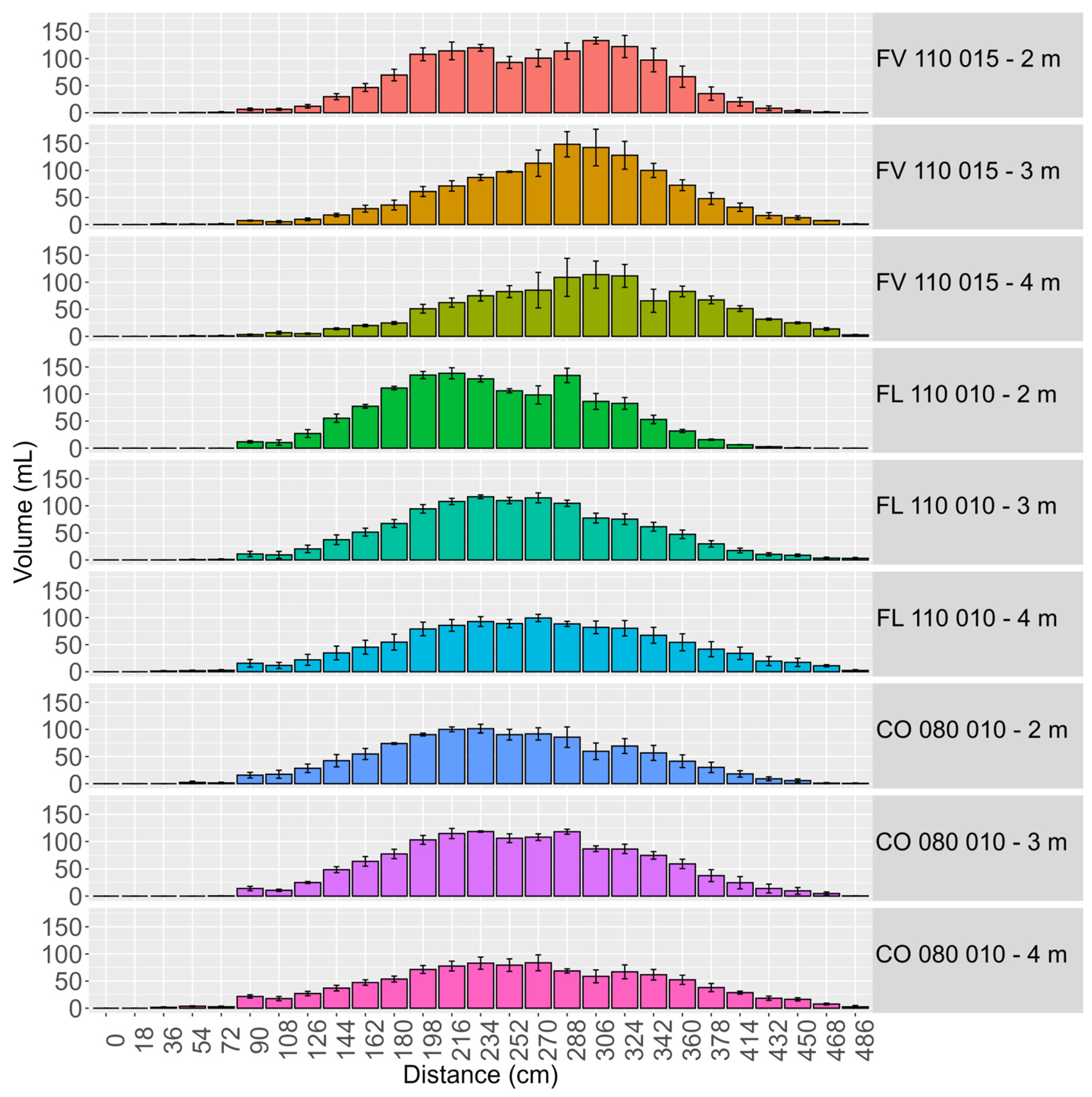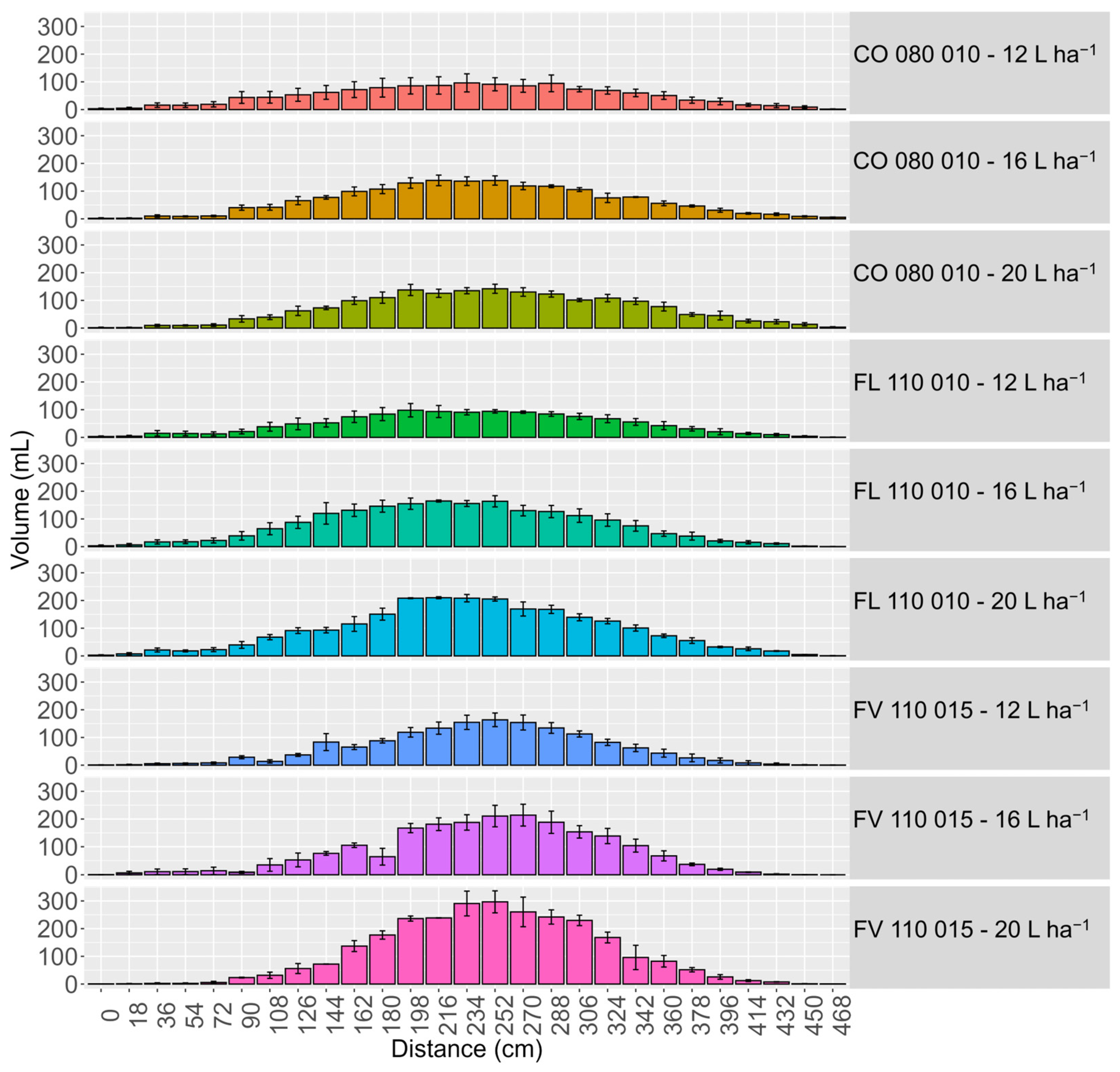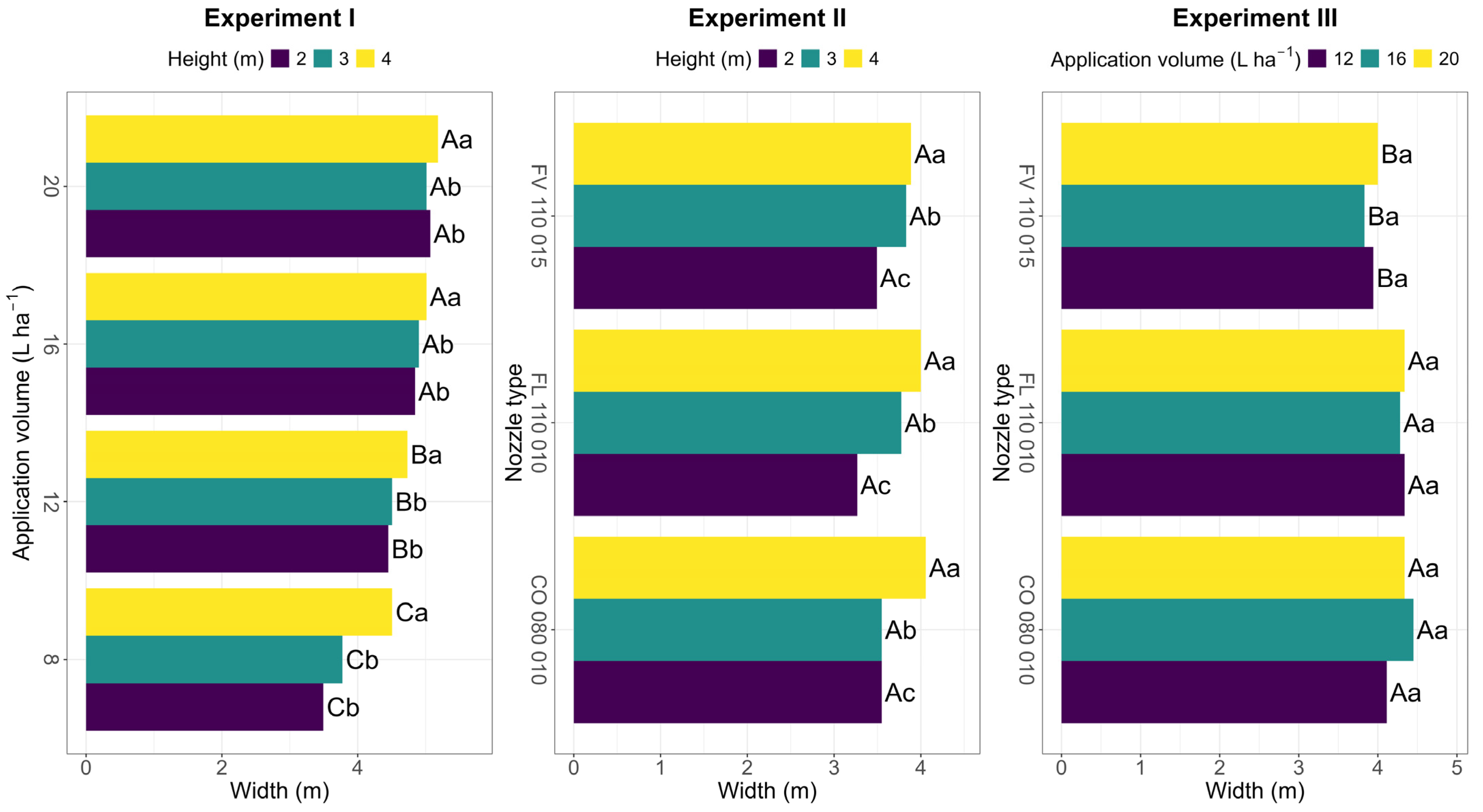Comparison of Volumetric Distribution in Drone Spraying Considering Height, Application Volume, and Nozzle Type
Abstract
1. Introduction
2. Materials and Methods
2.1. Drone Characteristics
2.2. Characteristics of the Spray Patternator
2.3. Experiment I
2.4. Experiment II
2.5. Experiment III
2.6. Measurement of Weather Conditions
2.7. Analyzed Variables and Data Processing
3. Results and Discussion
3.1. Volumetric Distribution
3.2. Spray Swath Width
3.3. Coefficient of Variation
4. Conclusions
Author Contributions
Funding
Data Availability Statement
Acknowledgments
Conflicts of Interest
References
- CNA—Confederação da Agricultura e Pecuária do Brasil. Após Dois Trimestres em Queda, PIB do Agro Reage no 3 tri e Recuo Esperado Para 2024 Diminuiu Para 2,49%. Available online: https://www.cnabrasil.org.br/publicacoes/apos-dois-trimestres-em-queda-pib-do-agro-reage-no-3o-tri-e-recuo-esperado-para-2024-diminuiu-para-2-49 (accessed on 2 March 2025).
- ANAC—Agência Nacional de Aviação Civil. Painel—Aeronaves—Drones Cadastrados. Available online: https://www.gov.br/anac/pt-br/acesso-a-informacao/dados-abertos/areas-de-atuacao/aeronaves-1/drones-cadastrados/painel-drones (accessed on 2 March 2025).
- DJI—DJI Agriculture. Agricultural Drone Industry Insight Report. Available online: https://www1.djicdn.com/cms_uploads/ckeditor/attachments/9171/03e81f9a23cf4df447b66c91c43d929a.pdf (accessed on 2 March 2025).
- Hafeez, A.; Husain, M.A.; Singh, S.P.; Chauhan, A.; Khan, M.T.; Kumar, N.; Chauhan, A.; Soni, S.K. Implementation of drone technology for farm monitoring & pesticide spraying: A review. Inf. Process. Agric. 2023, 10, 192–203. [Google Scholar]
- Filho, F.H.L.; Heldens, W.B.; Kong, Z.; Lange, E.S. Drones: Innovative technology for use in precision pest management. J. Econ. Entomol. 2019, 113, 1–25. [Google Scholar] [CrossRef] [PubMed]
- Kim, J.; Kim, S.; Ju, C.; Son, H. Unmanned Aerial Vehicles in agriculture: A review of perspective of platform, control, and applications. IEEE 2019, 7, 105100–105115. [Google Scholar] [CrossRef]
- An, Q.; Li, D.; Wu, Y.; Pan, C. Deposition and distribution of myclobutanil and tebuconazole in a Semidwarf apple orchard by hand-held gun and air-assisted sprayer application. Pest Manag. Sci. 2020, 76, 4123–4130. [Google Scholar] [CrossRef]
- Wang, Z.; Meng, Y.; Mei, X.; Ning, J.; Ma, X.; She, D. Assessment of handler exposure to pesticides from stretcher-type power sprayers in orchards. Appl. Sci. 2020, 10, 8684. [Google Scholar] [CrossRef]
- Silva, J.E.; da Silva, W.H.B.; Ferraz, M.A.J.; Menezes, E.A.S.; da Costa, O.P.; Inácio, F.D.; Barboza, T.O.C.; Melo, C.A.D.; Carvalho, G.R.; dos Santos, A.F. Impact of spray volume and flight speed on the efficiency of drone applications in coffee plants of different ages. Smart Agric. Technol. 2024, 9, 100694. [Google Scholar] [CrossRef]
- Yang, S. Características e análise de downwash de um veículo aéreo não tripulado de seis rotores configurado para proteção de plantas. Pest Manag 2022, 78, 1720. [Google Scholar]
- Lou, S.Y.; Xue, X.Y.; Gu, W.; Cui, L.F.; Xiao, H.T.; Tian, Z.W. Current status and trends of agricultural plant protection unmanned aerial vehicle. J. Agric. Mech. Res. 2017, 39, 6. [Google Scholar]
- Wang, J.; Lan, Y.; Wen, S.; Hewitt, A.J.; Yao, W.; Chen, P. Meteorological and flight altitude effects on deposition, penetration, and drift in pineapple aerial spraying. Asia Pac. J. Chem. Eng. 2020, 15, 2382. [Google Scholar] [CrossRef]
- Hu, H.; Ren, X.; Ma, X.; Li, H.; Ma, Y.; Wang, D.; Ma, Y. Control effect on cotton aphids of insecticides sprayed with unmanned aerial vehicles under different flight heights and spray volumes. Int. J. Precis. Agric. Aviat 2021, 4, 44–51. [Google Scholar] [CrossRef]
- Chen, S.; Lan, Y.; Li, J.; Zhou, Z.; Liu, A.; Mao, Y. Effect of wind field below unmanned helicopter on droplet deposition distribution of aerial spraying. Int. J. Agric. Biol. Eng. 2017, 10, 77. [Google Scholar]
- Hunter, J.E.; Gannon, T.W.; Richardson, R.J.; Yelverton, F.H.; Leon, R.G. Coverage and drift potential associated with nozzle and speed selection for herbicide applications using an unmanned aerial sprayer. Weed Technol. 2020, 34, 240. [Google Scholar] [CrossRef]
- Mota, A.A.B.; Antuniassi, U.R. Influência de adjuvantes no espectro de gotas de ponta com indução de ar. Energ. Na Agric. 2013, 28, 1–5. [Google Scholar] [CrossRef]
- Nuyttens, D.; Baetens, K.; De Schampheleire, M.; Sonck, B. Effect of nozzle type, size and pressure on spray droplet characteristics. Biosyst. Eng. 2007, 97, 333–345. [Google Scholar] [CrossRef]
- Cunha, JPAR da; Silva, RAM Uniformidade de distribuição volumétrica de pontas de concentração em função da pressão de trabalho e altura da barra. Rev. Biociências 2010, 26, 52–58.
- Massola, M.P.; Holtz, V.; Martins, M.P.d.O.; Umbelino, A.d.S.; dos Reis, E.F. Spray volume distribution pattern and droplet size spectrum from ceramic nozzles. Rev. Bras. Eng. Agrícola Ambient. 2018, 22, 804–809. [Google Scholar] [CrossRef]
- ISO 5682-1:2017; Crop Protection Equipment—Spraying Equipment—Part 1: Test Methods Spray Nozzles. International Organization for Standardization: Genebra, Switzerland, 2017.
- Chen, P.; Ouyang, F.; Zhang, Y.; Lan, Y. Preliminary Evaluation of Spraying Quality of Multi-Unmanned Aerial Vehicle (UAV) Close Formation Spraying. Agriculture 2022, 12, 1149. [Google Scholar] [CrossRef]
- Yallappa, D.; Kavitha, R.; Surendrakumar, A.; Suthakar, B.; Kumar, A.M.; Kannan, B.; Kalarani, M.K. Influence of the downwash airflow in Hexacopter Drone on the spray distribution pattern of boom sprayer. J. Appl. Nat. Sci. 2023, 15, 391–400. [Google Scholar] [CrossRef]
- Chen, P.; Ouyang, F.; Wang, G.; Qi, H. Droplet distributions in cotton harvest aid applications vary with the interactions among the unmanned aerial vehicle spraying parameters. Ind. Crops Prod. 2021, 163, e113324. [Google Scholar] [CrossRef]
- Zhang, Z.; Khanal, S.; Raudenbush, A.; Tilmon, K.; Stewart, C. Assessing the efficacy of machine learning techniques to characterize soybean defoliation from unmanned aerial vehicles. Comput. Electron. Agric. 2022, 193, 106682. [Google Scholar] [CrossRef]
- da Vitória, E.L.; Krohling, C.A.; Borges, F.R.P.; Ribeiro, L.F.O.; Ribeiro, M.E.A.; Chen, P.; Lan, Y.; Wang, S.; e Moraes, H.M.F.; Júnior, M.R.F. Efficiency of Fungicide Application an Using an Unmanned Aerial Vehicle and Pneumatic Sprayer for Control of Hemileia vastatrix and Cercospora coffeicola in Mountain Coffee Crops. Agronomy 2023, 13, 340. [Google Scholar] [CrossRef]
- Yan, Y.; Lan, Y.; Wang, G.; Hussain, M.; Wang, H.; Yu, X.; Changfeng, S.; Wang, B.; Canção, C. Evaluation of the deposition and distribution of spray droplets in citrus orchards by plant protection drones. Front. Plant Sci. 2023, 14, 1175794. [Google Scholar] [CrossRef] [PubMed]
- DJI. Agras T10. User Manual. v1.4. Available online: https://dl.djicdn.com/downloads/t10/T10_User_Manual_v1.4_EN.pdf (accessed on 2 March 2025).
- da Cunha, J.P.A.R. Análise da distribuição volumétrica de pontas de pulverização hidráulicas de jato plano. Rev. Ciências Agrárias 2008, 31, 233–239. [Google Scholar] [CrossRef]
- Maciel, C.F.S.; Teixeira, M.M.; Fernandes, H.C.; da Vitória, E.L.; Cecon, P.R. Distribuição Volumétrica e Espectro de Gotas das Pontas Hidráulicas LD 11002 E MAG-2. Rev. Eng. Na Agric. Reveng. 2017, 25, 183–199. [Google Scholar] [CrossRef][Green Version]
- ASABE S572.1 Droplet Size Classification. [s.l:s.n.]. Available online: https://cdn2.hubspot.net/hub/95784/file-32015844-pdf/docs/asabe_s572.1_droplet_size_classification.pdf (accessed on 2 March 2025).
- Vargas, L.; Gleber, L. Sistema de Produção de Ameixa Européia: Tecnologia de Aplicação de Defensivos. Embrapa Uva e Vinho, Sistema de Produção, ISSN 1678-8761, Versão Eletrônica. Available online: https://sistemasdeproducao.cnptia.embrapa.br/FontesHTML/Ameixa/AmeixaEuropeia/tecnologia.htm (accessed on 2 March 2025).
- Lan, Y.; Quian, S.; Chen, S.; Zhao, Y.; Deng, X.; Wang, G.; Zhang, Y.; Wang, J.; Qiu, X. Influence of the downwash wind field of plant protection UAV on droplet deposition distribution characteristics at different flight heights. Agronomy 2021, 11, 2399. [Google Scholar] [CrossRef]
- Wen, S.; Han, J.; Ning, Z.; Lan, Y.; Yin, X.; Zhang, J.; Ge, Y. Numerical analysis and validation of spray distributions disturbed by quad-rotor drone wake at different flight speeds. Comput. Electron. Agric. 2019, 166, 105036. [Google Scholar] [CrossRef]
- Wang, S.; Nuyttens, D.; Lu, D.; Beek, J.V.; Li, X. Airflow characteristics of a spray UAV and its effect on spray droplet transportation. Eng. Agrícola 2023, 43, e20230041. [Google Scholar] [CrossRef]
- Bueno, M.R.; Cunha, J.P.A.R.; Santanna, D.G. Assessment of spray drift from pesticide applications in soybean crops. Biosyst. Eng. 2017, 154, 35–45. [Google Scholar] [CrossRef]
- Yilong, Z.; Chen, P.; Xu, W.; Chen, S.; Han, Y.; Lan, Y.; Wang, G. Influence of the downwash airflow distribution characteristics of a plant protection UAV on spray deposit distribution. Biosyst. Eng. 2022, 216, 32–45. [Google Scholar] [CrossRef]
- Wang, G.B.; Yubin, L.; Qi, H.; Chen, P. Fiel evaluation of an unmanned aerial vehicle (UAV) sprayer: Effect of spray volume on deposition and the control of pests and disease in wheat. Pest Manag. Sci. 2019, 73, 1546–1555. [Google Scholar] [CrossRef]
- Yang, Z.; Ge, L.; Qi, L.; Cheng, Y.; Wu, Y. Influence of UAV rotor down-wash airflow on spray width. Trans. Chin. Soc. Agric. Mach. 2018, 49, 116–122. [Google Scholar] [CrossRef]
- Zhao, D.; Cooper, S.; Chima, P.; Wang, G.; Zhang, L.; Sun, B.; Zhang, X.; Lan, Y. Development and Characterization of a Contact-Charging Electrostatic Spray UAV System. Agriculture 2024, 14, 467. [Google Scholar] [CrossRef]
- Wang, G.B.; Lan, Y.; Yuan, H.; Qi, H.; Chen, P.; Ouyang, F.; Han, Y. Comparison of Spray Deposition, Control Efficacy on Wheat Aphids and Working Efficiency in the Wheat Field of the Unmanned Aerial Vehicle with Boom Sprayer and Two Conventional Knapsack Sprayers. Appl. Sci. 2019, 9, 218. [Google Scholar] [CrossRef]
- Xue, X.; Lan, Y.; Sun, Z.; Chang, C.; Hoffmann, C. Develop an unmanned aerial vehicle based automatic aerial spraying system. Comput. Electron. Agric. 2016, 128, 58–66. [Google Scholar] [CrossRef]






| Nozzle Type | Flow Rate (L min−1) | Spray Angle (°) | Color | VMD (μm) | Classification |
|---|---|---|---|---|---|
| FV 110 015 | 0.57 | 110 | Green | 404–502 | Very Coarse |
| FL 110 010 | 0.38 | 110 | Orange | 106–235 | Fine |
| CO 080 010 | 0.38 | 80 | Orange | 106–235 | Fine |
Disclaimer/Publisher’s Note: The statements, opinions and data contained in all publications are solely those of the individual author(s) and contributor(s) and not of MDPI and/or the editor(s). MDPI and/or the editor(s) disclaim responsibility for any injury to people or property resulting from any ideas, methods, instructions or products referred to in the content. |
© 2025 by the authors. Licensee MDPI, Basel, Switzerland. This article is an open access article distributed under the terms and conditions of the Creative Commons Attribution (CC BY) license (https://creativecommons.org/licenses/by/4.0/).
Share and Cite
Alves, R.F.Q.; Silva, J.E.; Orlando Costa Barboza, T.; Ferraz, M.A.J.; Costa, O.P.d.; Silva, W.H.B.d.; Inácio, F.D.; Oliveira, L.P.d.; Melo, C.A.D.; Santos, A.F.d. Comparison of Volumetric Distribution in Drone Spraying Considering Height, Application Volume, and Nozzle Type. AgriEngineering 2025, 7, 123. https://doi.org/10.3390/agriengineering7040123
Alves RFQ, Silva JE, Orlando Costa Barboza T, Ferraz MAJ, Costa OPd, Silva WHBd, Inácio FD, Oliveira LPd, Melo CAD, Santos AFd. Comparison of Volumetric Distribution in Drone Spraying Considering Height, Application Volume, and Nozzle Type. AgriEngineering. 2025; 7(4):123. https://doi.org/10.3390/agriengineering7040123
Chicago/Turabian StyleAlves, Raí Fernandes Queiroz, Jéssica Elaine Silva, Thiago Orlando Costa Barboza, Marcelo Araújo Junqueira Ferraz, Octávio Pereira da Costa, Wender Henrique Batista da Silva, Franklin Daniel Inácio, Luan Pereira de Oliveira, Christiane Augusta Diniz Melo, and Adão Felipe dos Santos. 2025. "Comparison of Volumetric Distribution in Drone Spraying Considering Height, Application Volume, and Nozzle Type" AgriEngineering 7, no. 4: 123. https://doi.org/10.3390/agriengineering7040123
APA StyleAlves, R. F. Q., Silva, J. E., Orlando Costa Barboza, T., Ferraz, M. A. J., Costa, O. P. d., Silva, W. H. B. d., Inácio, F. D., Oliveira, L. P. d., Melo, C. A. D., & Santos, A. F. d. (2025). Comparison of Volumetric Distribution in Drone Spraying Considering Height, Application Volume, and Nozzle Type. AgriEngineering, 7(4), 123. https://doi.org/10.3390/agriengineering7040123











